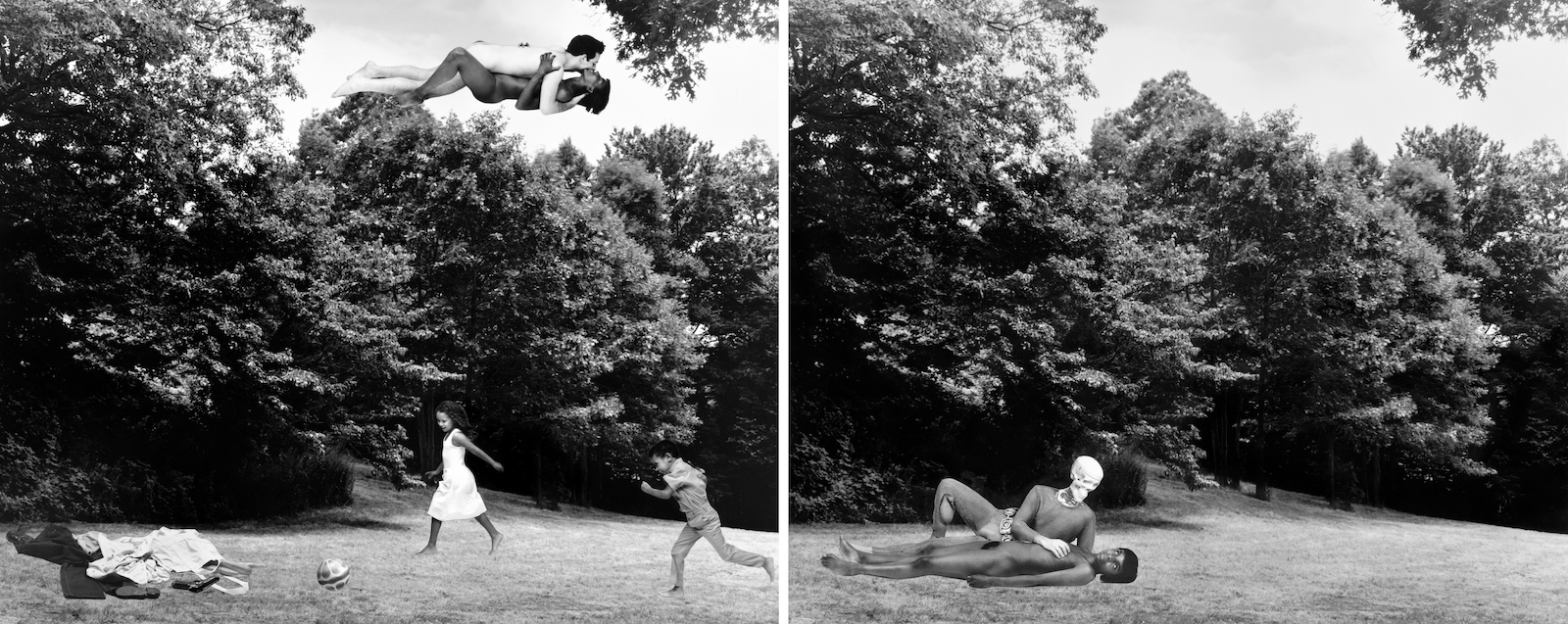[December 1, 2021 | Season 2, Ep. 3 | Barbara London Calling]
Barbara London: My guest today is the acclaimed artist and inspired thinker Lorraine O’Grady. During her productive career, Lorraine has engaged in a range of disciplines, from performance and dance to photography, writing and the moving image, all while investigating the politics of diaspora and identity. Born in Boston in 1934 to Caribbean immigrant parents, Lorraine served as an intelligence analyst for the U.S. government, moved on to become a literary and commercial translator, then a rock music critic before she turned to visual arts in the late 1970s. Welcome, Lorraine. I’m delighted to speak with you today.
Lorraine O’Grady: Thank you. I’m very happy to be here.
[Continue reading for full transcript.]
Transcript
BL: Let’s start with your art practice as it evolved in the late ’70s. Tell me a little bit about arriving in New York and those formative years. I know you were a vigilant volunteer at the Just Above Midtown gallery (JAM) in Manhattan. I’m curious, what was the atmosphere there like? At the time, artists like David Hammons were coming by, and the prescient gallery director Linda Goode Bryant was pretty astute. What was that like?
LO’G: It was really wonderful, but you couldn’t say that it was perfect because the gallery felt like a gallery living in sort of isolation. It was a gallery basically devoted to the Black avant-garde, and the white and black art worlds were totally separate at that time. There was a pretty rigid system, conscious or unconscious, of segregation in the art world. The thing about JAM was that it had become the de facto art world for the people who were there. When they weren’t working in their studios, they were coming down to the gallery to just hang out for their social life and to talk about art. Even as the gallery was setting up a new space on Franklin Street from the ground up, people would be helping with the scraping and the painting. When they were not in their studios, they would be hanging out in the front talking. Then there was an outdoor restaurant and bar down the street, where they’d be drinking white wine spritzers.
The talk was always excited and always about art. I think some people were keeping up with the white art world. Others didn’t care about the white art world. There was a sense that the really important art world was what was happening at JAM, and that made it a very exciting place to be, really.
BL: Let’s move on to what I think maybe evolved out of that experience at JAM. I want to turn to your performance, Mademoiselle Bourgeoise Noire, which in French means Miss Black Middle Class. I believe you had a photographer in tow. You arrived uninvited to the 1980 opening of the New Museum’s “Persona” exhibition.
LO’G: May I interrupt you there just for one second?
And that is, I did not have a photographer in tow when I did the performance at Just Above Midtown. I was pretty naïve. I was just starting out. I didn’t even realize that you needed to have your work documented. I was going down there to do it, but then I realized after the performance, there was one image shot at the night of the performance that appeared in the SOHO Weekly news, and it really didn’t have anything to do with my idea of the performance. I realized I had better get something down on record. I went back two days later to an empty gallery to try to re-perform what I had done. And that didn’t work, either.
So, the first time I actually documented that performance was a year later when I did it at the New Museum.
BL: When you went to the New Museum, to the “Persona exhibition,” I think the museum was only three years old. I really love the images that I’ve seen. You wore a white ball gown made from 180 pairs of white gloves that you bought at local thrift stores, and you carried a cat-o-nine tails made of sail rope studded with white chrysanthemums.
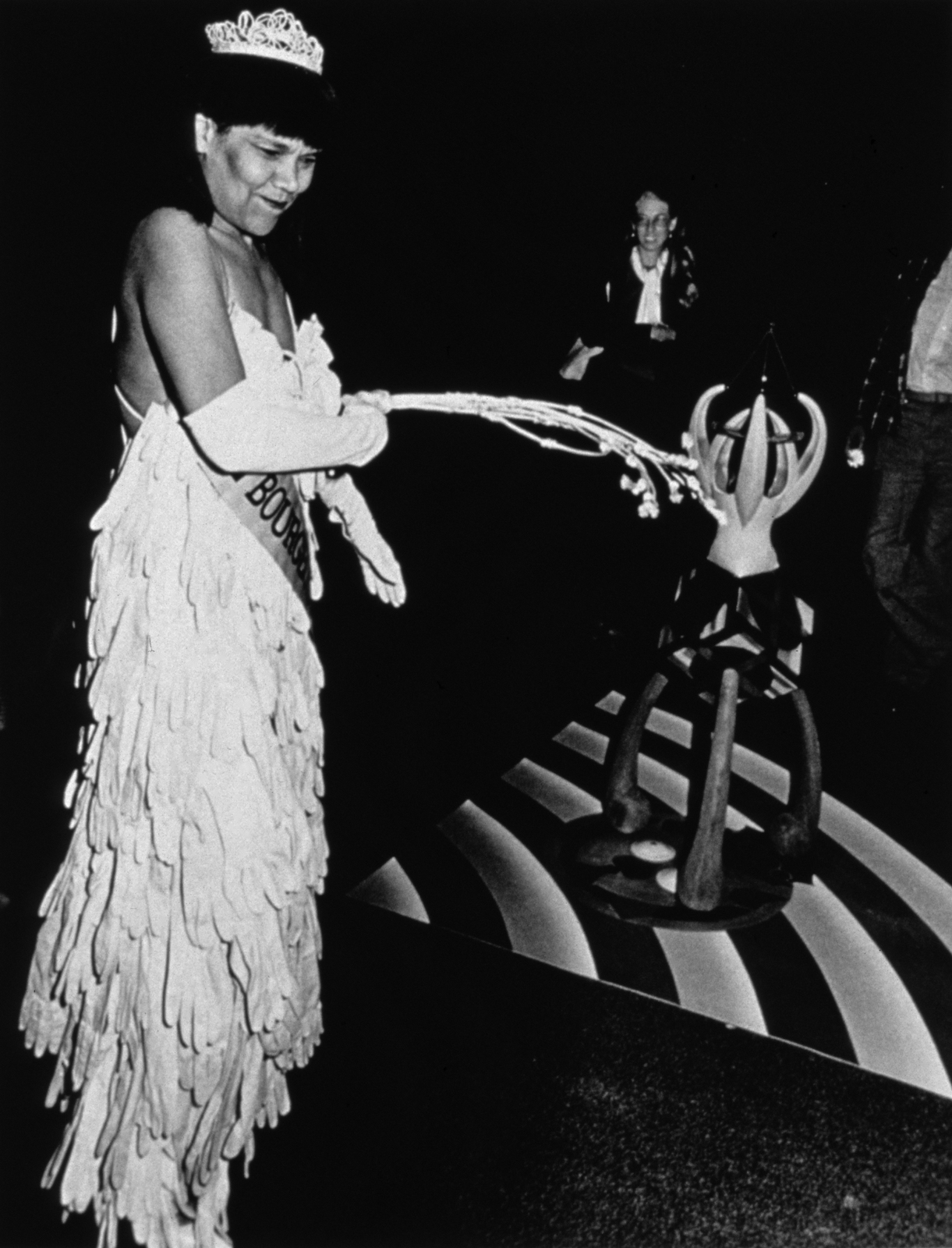
To me, it was as if you were a beauty queen. You wore a beauty pageant-like sash with the words “Mademoiselle Bourgeoise Noire,” and in the photo documentation, you’re glamorous. You have this wonderful radiant smile, even though the work referenced quite weighty topics such as slavery and servitude. I’d love to know a little more about the work. Also, I read that afterwards that you felt disappointed about the performance. I wonder why?
LO’G: Well, actually, the documentation that I got that night was pretty accurate in portraying the many different moods that I went through. I wasn’t always smiling radiantly. In order to do that performance, I had to employ a variety of emotions, and I would say that the most typical was a sort of going back and forth between almost violent anger at the situation that I was there to protest, and sort of joy and elation at the very act of performing and having friends out in the audience and so forth. It was a combination of joy and anger that enabled me and was present in the performance. What happened next was that only one image of the performance became circulated, and that was one of me very angry screaming out my poem.
So, for almost thirty years I would say, the performance and people’s knowledge of it was the prisoner of this single image of me shouting that had sort of become an empty signifier. One of the wonderful things that’s happened since then is that I’ve been able, through the website and other things, too, to give the full impression, which is the one that you seem to have received. I’m very happy about that. But the evening of the performance, I would say, nobody was expecting me, and they thought I must be part of the show. There was a sort of gradual awareness, as the performance continued, that I was not part of the show and that there were some people who were pretty angry. “What is this person doing here who doesn’t even belong here?”
Then there were other people who were just so blown away, enamored by the beauty of the performance and the energy of the performance that they were beginning to participate from the sidelines. It was a combination of reactions that took place there. When I did the performance at Just Above Midtown, I had a poem that ended with a punchline, “Black art must take more risks.” After I beat myself with the “whip-that-made-plantations-move,” at the New Museum, I shouted out a poem. The punchline at the New Museum was, “Now is the time for an invasion.” The punchline was actually still being addressed to black artists to not be timid, not to accept this situation of segregation, but to take active steps to protest, to start proceeding less from a standpoint of playing it safe and trying to just do good work, but taking more activist stance is what I was calling for, I think.
BL: The show at the New Museum was called “Persona,” and it featured the work only of white artists.
LO’G: Yes, I ended up calling it the “Nine White Persona Show,” and it was insulting because they had asked me to do the outreach for the show. They knew about Mademoiselle Bourgeoise Noire, but they asked me to do the outreach to school children. And so, I told the director of education who had contacted me, “Well, why don’t we wait until after the opening.” And then something pretty terrible happened. After the opening, I got a typed letter from him saying that I was dis-invited from doing outreach. It was a different time, and I don’t think people had a way exactly of parsing out all of what was actually going on in the performance or why the performance was being made or anything like that.
BL: A few years later, in 1983 you created a performance called Art Is. It was a very community-oriented event that you carried out at the African American Day Parade in Harlem. You created a nine by fifteen-foot antique-style gold frame, which you mounted on a gold skirted float. The float slowly traveled up Adam Clayton Powell Boulevard, framing everything it passed as art. I think you had fifteen young actors and dancers dressed in white, each holding a gold picture frame. They then framed individual viewers. There were all these shouts, “Frame me! Make me art!” I guess the impetus behind the performance was your answering a challenge, which is a pretty stiff challenge made by a non-artist acquaintance who said to you, “Avant Garde art doesn’t have anything to do with black people.” Do you want to say something?
LO’G: You asked a question before about my feeling that the Mademoiselle Bourgeoise Noire was disappointing, why did I feel that? I had come to the point where I realized that just shouting out these poems wasn’t going to do much. It wasn’t going to change anything; it was a way of stating what the problem was. But I needed to go further than just stating the problem. I had to provide answers for the problem. The first thing that I did as Mademoiselle Bourgeoise Noire was turn her into an impresario. She curated a show at the Kenkeleba Gallery, which was a black-owned gallery in the East Village. That show was called “The Black and White Show,” with fourteen white artists and fourteen black artists, and all the work was in black and white. I thought that holding the color of the work still, stabilizing that and putting an equal number of black and white artists in the show, that a conversation might be able to happen on the walls that I had never seen in the white art world. Actually, a Whitney Biennial was held that year, and only three people of color were in that Biennial, including Jean-Michel Basquiat.
So, for the 1983 Whitney Biennial, regardless of all the energy and all of the wonderful artists at Just Above Midtown, not a single one, including David Hammons, had received a studio visit for the Biennial. So, I was putting on something three weeks after the Biennial closed, which was kind of my own Biennial. Well, it didn’t work that well, I would say, because it only got a half a paragraph review in the East Village Other, but a few months after that, Mademoiselle Bourgeoise Noire went out again in a different way. The first performance had said this is what the situation is. And the second performance had said these are who the artists should be. Now, I went to Harlem with an artist performance in order to say, this is who the audience should be.
It was a very frightening performance for me to do, because I didn’t know Harlem very well at all. Because I’m West Indian, I was very familiar with Brooklyn and the community of West Indian immigrants there. But I didn’t really know Harlem, and I didn’t know whether the performance would work. The only way I had of communicating with this million or so people that were on the parade route—it’s really amazing when you think about it, a million people—the only way I had communicating with them was, I wrote on the side paper of the float, “Art is…” on both sides. So, the performance could work, but it might not have worked. After a while, I began hearing these shouts, “That’s right! That’s what art is! We’re the art!” And then “Frame me! Frame me! Make me art!”
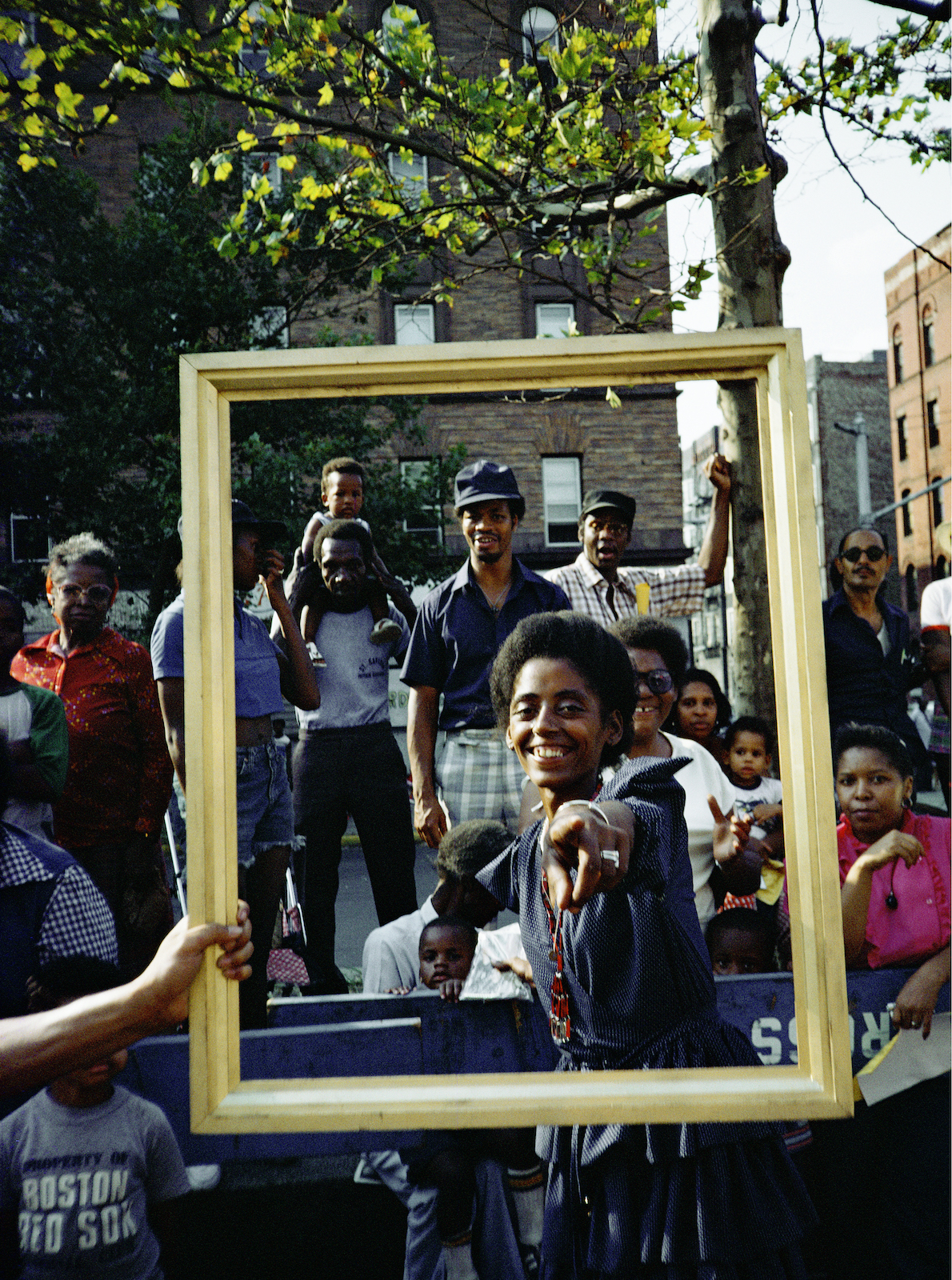
I just couldn’t believe my ears. It was working better than I ever could have imagined, and I thought that performance was a successful venture of Mademoiselle Bourgeoise Noire. The only way I had of saying this was a Mademoiselle Bourgeoise Noire performance was that I pinned on my own chest—I was wearing a sort of karate outfit with a white T-shirt—I pinned my own white gloves to my T-shirt. I had not had the courage to put my own white gloves in the original costume of 180 pairs of white gloves, because I was perhaps afraid to admit my own complicity as a member of the black middle class, in the need to play it safe. But I had sort of emerged from this ethos of playing it safe and putting your head down and just doing what had to be done. I emerged from that with not just do what has to be done, or play it safe. But let’s go out there and make a revolution. But it was just wonderful to see the response to the float of the people there, the young people framing themselves with small frames.
BL: You just had an amazing retrospective at the Brooklyn Museum. I found the title of your exhibition provocative, “Lorraine O’Grady: Both/And.” When I saw your photographic work, Miscegenated Family Album, which has the dates 1980–94, I loved how it was unpretentiously installed in the Brooklyn Museum’s Egyptian galleries. The Miscegenated Family Album has sixteen Cibachrome diptychs and features your sister. The diptychs evolved out of your 1980 performance of Nefertiti/Devonia Evangeline, and the pairs of slides from the performance were a comparison of your sister and Nefertiti and their families. That was projected behind your live action.
You retired the performance in 1988, because you said it felt emotionally and theoretically redundant. For me, your early and recent work that was featured in your Brooklyn Museum retrospective made the Museum come alive. Maybe you could tell me about the juxtapositions, your choice of the location for your work in specific collection galleries. For example, Miscegenated Family Album was presented in the ancient Egyptian galleries.
LO’G: All of my work is very over-determined. There were many different motivations in making the performance. One of them was a simple one, which was really to reconcile my relationship with my sister who had died several years earlier, to affect a sort of ritualized reconciliation with my sister. I had been in Egypt shortly after she died. While I was there I walked across this square, the largest and the most well-placed square in Cairo, the one that’s now called Tahrir Square, the Freedom Square, the one that they used in the spring of whatever. I was crossing that square, when I had just come from an appointment at the U.S. Embassy. I was still sort of technically employed by the U.S. government, and I had checked in at the Embassy. I was leaving there to go get some American Express traveler’s checks in the Hilton on the other side of the square.
As I crossed the square, it was the first time I found myself completely surrounded by people who looked like me. This was something that had not happened in Boston where there was a very small black population, and it had not happened in New York, in Harlem. It was the first time that I was surrounded by people who definitely, to me, all looked mixed-race. Then I went down into the basement of the Hilton, where they had the American Express office, and the young Egyptian people behind the counter all started speaking to me in Arabic. When I said, “I’m sorry, but I don’t speak Arabic,” there was a young woman teller who said to the other tellers, “Oh, she’s such a snob! She doesn’t speak Arabic.”.
I came back from Egypt, and I sort of became an amateur Egyptologist. When I discovered the Amarna Period of Nefertiti and her husband, Akhenaten, it made such an impression on me. Akhenaten is the one who was the first monotheist. He had broken from the official Egyptian religion and found his own monotheistic religion. He and Nefertiti had gone to this place outside Thebes in the desert and built an incredible city there. This was the city that was excavated by the German archeological team, and they uncovered the sculptor Thutmose‘s studio with all of these magnificent, very realistic sculptures, one of which is the famous sculpture in Berlin of Nefertiti.
When I saw this work, and I learned more about the situation of Nefertiti, I discovered that Nefertiti had a younger sister, six years younger than she was, whose name was Mutnedjmet, or at least that’s what she was called at the time I was making the performance. I think they’ve since discovered that her sister had a different name. But Nefertiti was the elder of two sisters, and I was the younger of two sisters. I was eleven years younger than my sister Devonia, and there’d always been friction and separation between us, and we had not really reconciled our relationship when she died. I was able to use the relationship between Nefertiti and Mutnedjmet as a way of understanding more deeply my own relationship with Devonia.
That was the primary personal reason for making the performance.
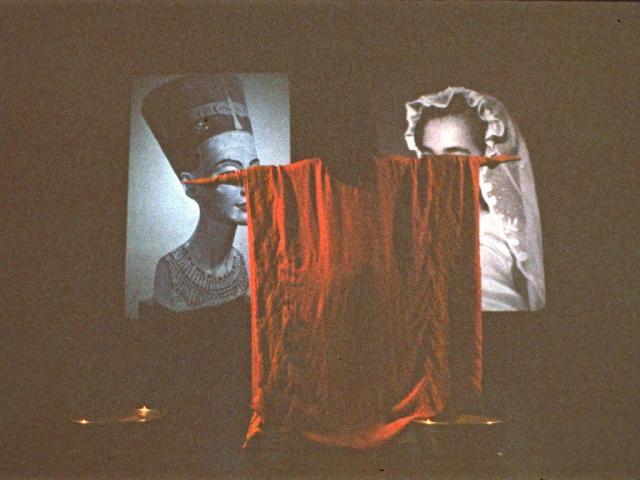
The other important reason was to establish what I felt was something that Egyptology as a whole was resolutely willing itself not to see, and that was that Egypt was a hybrid country. It wasn’t just a Middle Eastern country. It was a Middle Eastern/African country. I didn’t see how you could understand Egyptian culture without understanding its roots in the south, in Nubia and elsewhere. Everything we know about Egypt as Egypt, the pyramids, the hieroglyphs, the nature of kingship, the nature of the religion, all of these things had been established in the country’s southern region and were completely congruent with the countries south of Egypt.
I felt that Egypt had not really become its fullest self until the south conquered the north, the white north. The black south basically conquered the white north and combined it into a single country. When that happened, I think that’s when Egypt really began to flourish as a civilization, as a hybrid civilization. For me, ancient Egypt always represented one of only two hybrid civilizations that I personally know about. And that was ancient Egypt and Al-Andalus, which was the culture, the state that was imposed on Spain by the Moors of North Africa. The spirit of Al-Andalus was such that, in the universities for example, positions were held by whoever was the expert on the topic, whether they were Spanish and Christian, or Moorish and Muslim. It was just a brilliant hybrid culture.
I felt that these two examples were things that I wanted to promote, but unfortunately, Egyptology was not ready for me. I was doing this performance perhaps eight or nine years before Martin Bernal did the first volume of his four-volume series of books, which proved the influence of Egypt on ancient Greece. The series quartet of books was called Black Athena, but that had not happened yet. So, I had nothing but resistance, and basically, to be honest with you, nothing but resistance from Egyptology for three decades afterwards. I would say that in my retrospective perhaps, for me personally, the biggest victory was seeing, not just seeing Miscegenated Family Album hung in the Egyptian galleries, but actually a panel, a wall text that I didn’t write but that the curators of the Egyptian department wrote, that in fact, Egyptology has sort of almost willfully refused for centuries to acknowledge the Africanicity of ancient Egypt.
To see my piece there, in a changed environment with a changed attitude by Egyptology itself ready now to accommodate my ideas, that was the biggest victory for me.
BL: That is fantastic. I think that what you do is conceptually and technically amazing/insightful. You and I spoke a while earlier about another work in the Brooklyn Museum show. When I came around the corner from the Miscegenated Family Album and saw Landscape (Western Hemisphere) (2010), I was struck by this abstract kind of Monet Water Lilies-sized projection. What I saw was this close-up of your gently rustling, dramatically lit hair. I gather you had fans, and you had wonderful, natural sounds that came from nature, including the white noise sounds that cicadas make. It’s a very beautiful and moving work. When I first looked at it, I thought, “What material is that?” But of course, it’s your hair.
I understand that when you made the work, you did pretty much yourself. You told me there was a connection to Hallwalls, a young woman who was curator, is that right?
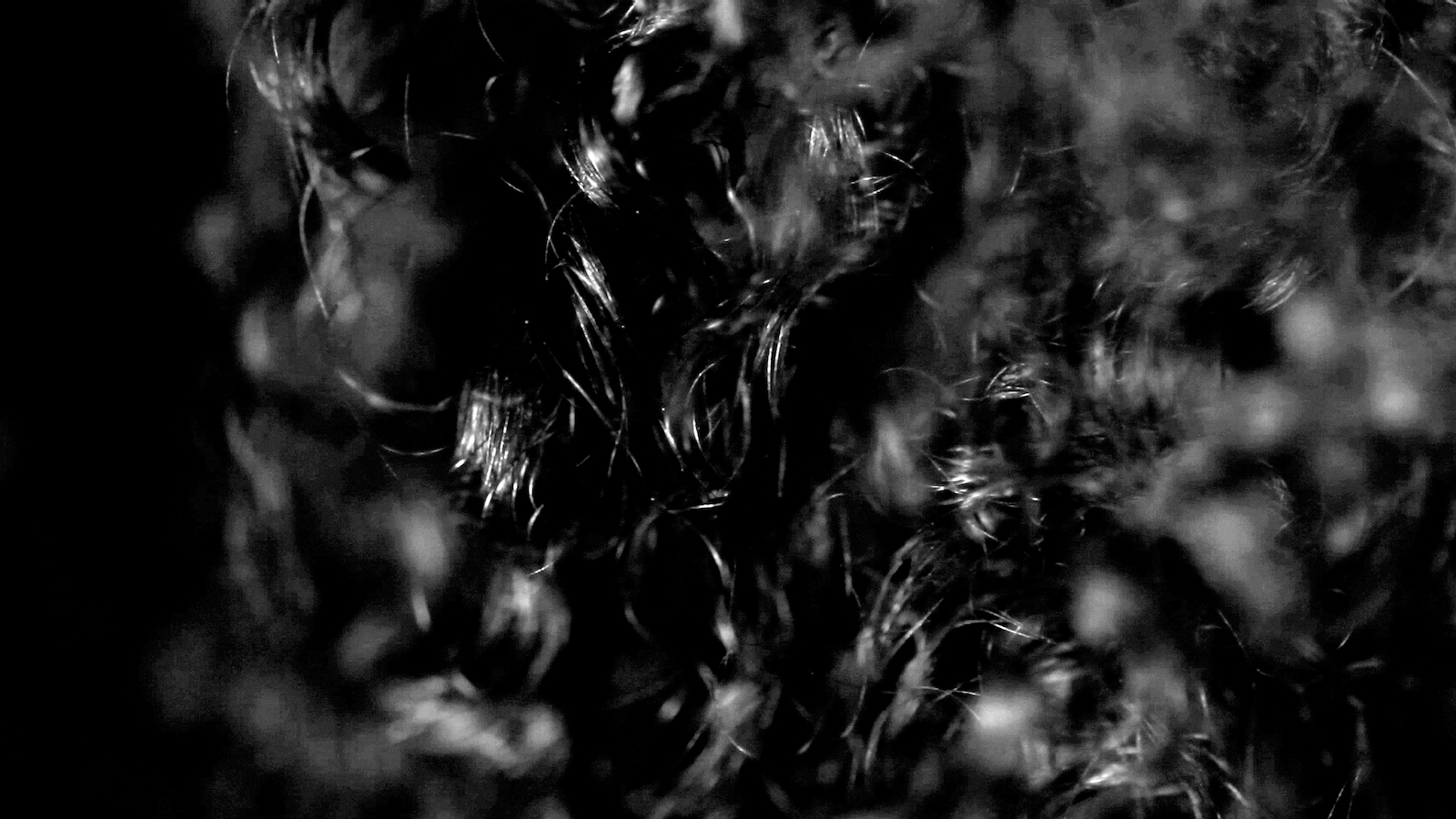
LO’G: Yes. Actually, I made Landscape (Western Hemisphere) as a way of deepening and broadening, giving viewers a different understanding of a diptych that I had made earlier, from the body of work that I call Body is the Ground of my Experience (1991-2019). There’s a diptych in that series called The Clearing. There was a lot of misunderstanding about The Clearing because in the left-hand panel it had a mixed-race couple, a black female and a white male making love above the trees. They were floating above the trees. Down on the ground below them, their mixed-race children were playing. In the right panel, the scene is changed and sort of down on the ground.
I told the black female model to look bored, and she did. She was lying on the ground naked, and above her was the same young white man. But now he was wearing a very tattered outfit of chain mail, and he was grasping her breast very proprietarily. I put him in chain mail because I thought that this relationship, which I feel is the founding relationship of the Western Hemisphere, was the death of courtly love. I had to rename The Clearing in order to make it clearer what I was talking about. When I did, I called it The Clearing: or Cortés and La Malinche, Thomas Jefferson and Sally Hemings, N and Me (“N” for any name, and “Me” for myself). This interrelationship, I felt, was what made America America, phenotypically to a lesser extent than culturally.
I felt that this relationship also had a very dark side, in the sense that it was the relationship that ended courtly love. Because as this relationship was taking place, of course, in every plantation in the south, there was a white woman who was getting more and more upset at what was going on around her, and she was unwilling to recognize that it wasn’t just happening on other people’s plantations—it was happening on her own. For me, the relationship ran the full gradation from the bright side to the dark side. The dark side was, I felt, the end of courtly love. But when I put it on the wall without explaining all of that, most people thought it was a before and after. They said, “Well, is this the before and the after of this relationship?” I said, “No. It’s a simultaneous piece. It’s the both/and of this kind of relationship. There’s always both ecstasy and exploitation, in probably any relationship you can think of, both of those things combined. But in this place, more severely, more extremely.”
I’d had to rename the piece with the names of these historic figures. I wasn’t happy at having done that. I thought it was rather reductive. So, I wanted to make a piece about the complexities of this relationship now, by using my hair, which is very mixed-race hair. It was wonderful because it worked better than I thought it would work. Because I had put a lot of hair products on my hair and whatnot, my hair was very glossy and silky when we started the filming. But by the end of eight hours of shooting, it had all dried out, and it looked like tumbleweed. That meant I had footage to work with in that film, which went between looking like silk and looking like dried up tumbleweed. I thought that was very much a symbolic reconciliation of the situation in The Clearing diptych, but in a very naturalistic way.
BL: I learned a lot about your practice by watching a 20-minute video that is in your installation entitled Looking for a Headdress, part of the installation you made for the 2015 exhibition “En Mas: Carnival and Performance Art of the Caribbean.” at the Contemporary Art Center in New Orleans, and circulated by Independent Curators International.
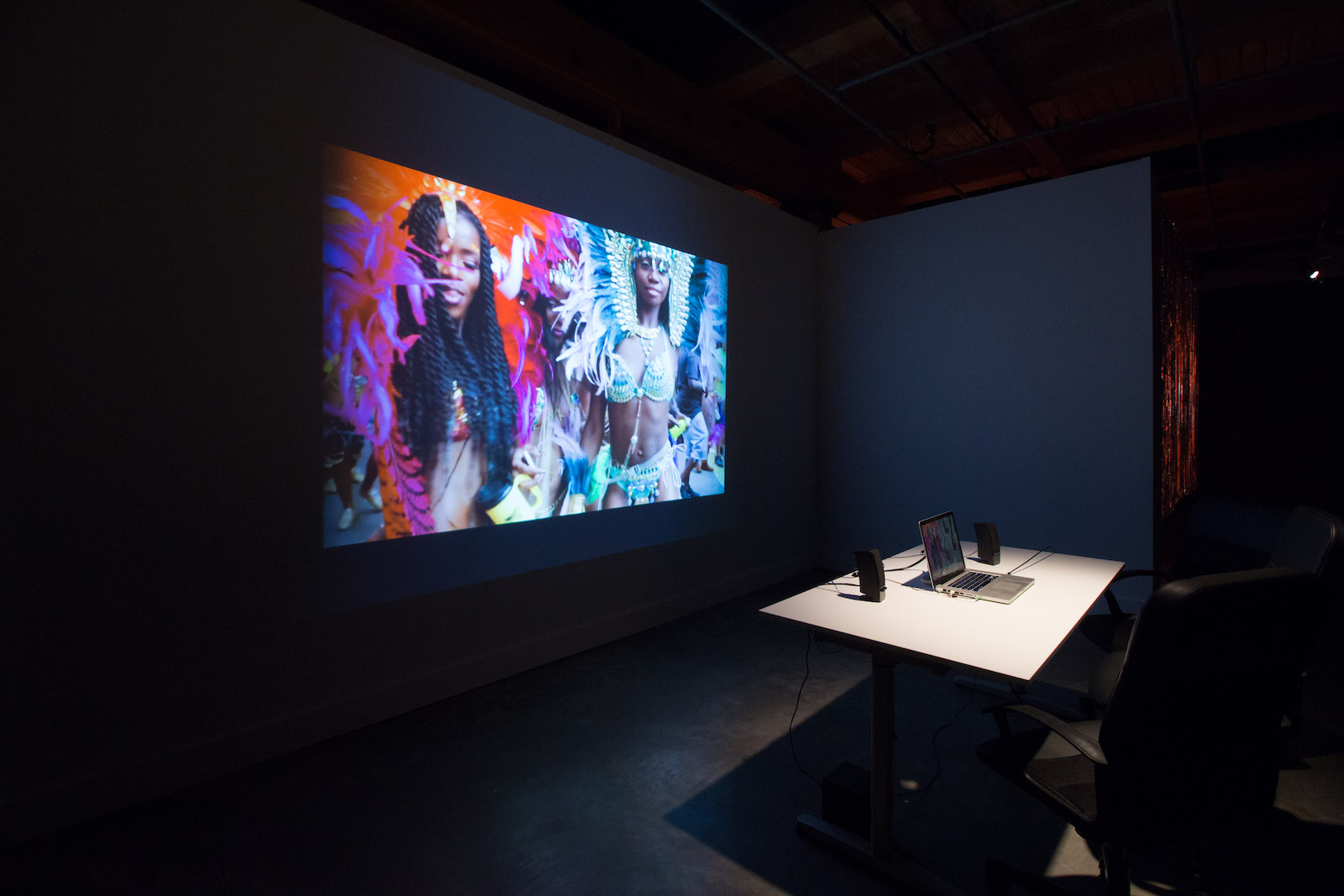
The work is full of information. In the video, you sit in your studio in Westbeth with Andil Gosine, an Indo-Canadian, Trinidadian, a professor of sociology and gender studies. You both are watching old YouTube videos of Brazilian carnivals and recent footage of the Brooklyn West Indian American Day Parade. I gather, at the time, you were developing a new character, a kind of avatar of your very iconic Mademoiselle Bourgeoise Noire.
The outfit for this new persona combined a Western garment and a carnival headdress. I gather you looked through very traditional ones, but you ended up with an unconventional one with a palm tree. I was fascinated by how you situated the installation. The viewer sat down at a desk with a computer and monitor and participated in the research you were doing by clicking and moving through the information. Do you want to talk about your intention with engaging the viewer that way?
LO’G: I really did go on a search for a headdress. I had a character that I knew was going to wear armor, and a very particular form of armor. The armor that I wanted to wear was the armor of a very late-stage of armory, which is late 16th early 17th century, just about the early 1600s when the east came west, when Europe came to America. The armor that I wear is armor that would have been worn by the Conquistadors.
I had the armor, but I didn’t have the headdress. I knew that I wanted this headdress to establish the hybridity of the Western hemisphere, or would help me to do that. I knew where there were very fantastic headdresses worn in Carnivals all over the Caribbean, all over South America. So I went online on YouTube, which at that time was still a very wonderful resource, and I looked at Carnivals everywhere. I made a video out of this process of searching, and I put up the most interesting of the videos that I found. And I just kept going. Then I went to the West Indian Day Parade Carnival in Brooklyn, and I had my team shoot there. That was the last part of the actual shoot of Looking for a Headdress. But then, just before I finished, I actually found the headdress that I was looking for. It was in an early 19th century book by Isaac Mendes Belisario, who was part of a very well-known Sephardic Jewish family that lived in Jamaica and had lived there for centuries.
It was a Sephardic family that also was slave-owning and slave trading. One of the younger sons of the family was an artist. And he was interested in things like, how does Carnival look. Isaac Belisario made a notebook. They were a portfolio of lithographs, but they had many different forms. Believe it or not, he made the portfolio in 1832, which was just before slavery was outlawed in Jamaica. Within a year after slavery was outlawed, Carnival was outlawed. It was because Carnival had always been a place where the slaves could use cynicism and irony to critique their masters. They were free on the two days of Carnival to do that.
Belisario had made pictures of various characters figures in Jonkonnu, which is the Jamaican Carnival, and one of them was a figure called Actor Boy.
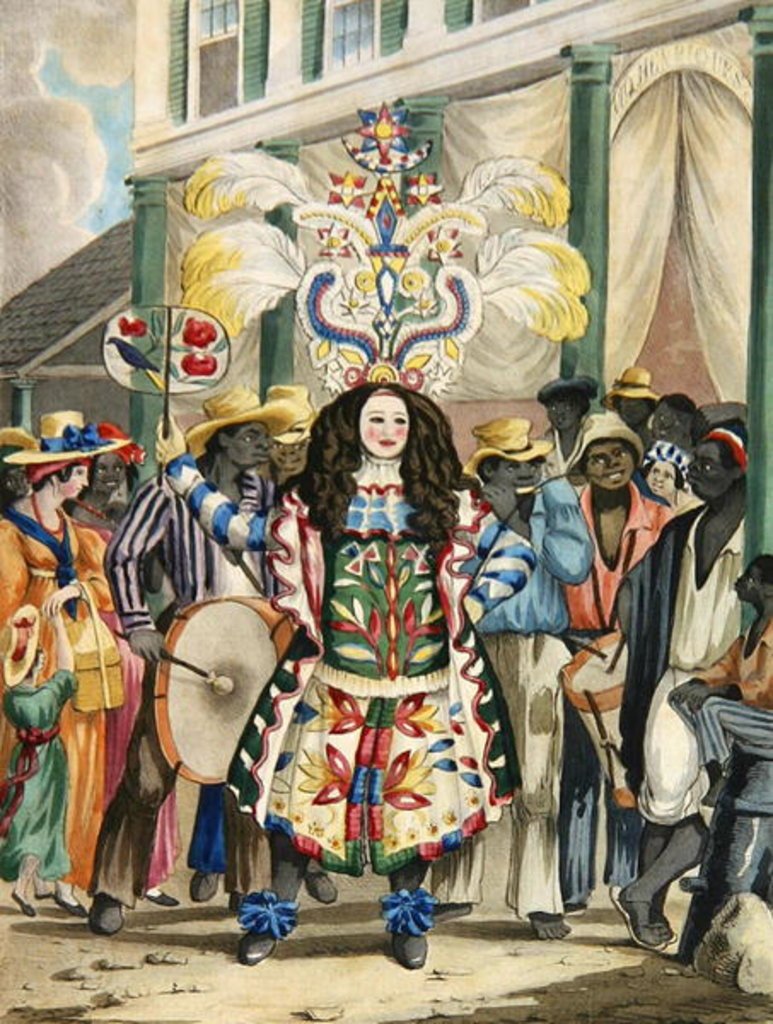
Actor Boy was one of the more professional of the figures in that Carnival, and he was somebody who wore a dress. Always a male wearing a dress. And he had a tall, tall headdress that almost looked like a Christmas Tree. I said, “That’s what I’m going to use for my headdress for Lancela Palm-and-Steel, as I call her. The adaptation that I made was pretty crude. I just put a literal palm tree on top of my helmet. I hope that it makes the point of these two cultures coming together as a way to represent the true nature of the Western hemisphere.

BL: I think it’s unbelievable how you just keep on marching to a steady beat, drawing from your profound research and your amazing imagination. I gather this outfit, this armor and the palm tree headdress will become another performance. Photos of you wearing armor and the palm tree headdress were exhibited at the Brooklyn Museum and were on the covers of your catalog.
LO’G: I called the exhibition at the Brooklyn Museum “Both/And” because I realized that sometimes you start doing this work, and you think you know what you’re doing, but you don’t really. You’re really finding out what you want to do as you do it. It took me a little while to understand that I used the diptych in the very first works that I did, like Nefertiti/Devonia Evangeline in 1980. But it probably wasn’t until the 1990s that I began to theorize it more carefully. I realized that the diptych was my weapon of choice in this fight that I was trying to wage. I consider the biggest obstacles that we are facing to a world of equality is this sort of either/or philosophical underpinning of western culture. It’s not culture and nature; it’s culture or nature, culture better than nature. It’s always hierarchical. It’s always oppositional.
It’s always not good and evil; it’s good or evil, good better than evil. Not ever any recognition that all of these qualities like joy and anger to make the Mademoiselle Bourgeoise Noire performance. All of these qualities are intrinsic in all of us, and they are a part of us, sort of a dance that we have to perform in order to remain fully human. Trying to eliminate one or the other, trying to be all good or all bad, you’re headed for trouble. I felt that the best way for me to encapsulate my program as it were, as an artist, was to start to foreground this both/and, anti-binaristic logic that I feel. Because I believe that the binary, the either/or is spreading inequalities wherever you go. Every area of life. And I think that white supremacy, for instance, is only one of the inequalities it fosters in Western culture.
BL: Well, you have an amazing career. I’m very grateful that you’ve given the time today, and I’m very grateful for all that you’ve created. This includes your website. You’ve been on the internet from the get-go, and your website is remarkable. You told me that you designed it.
LO’G: I feel like I was lucky. I happened to land at Harvard at the Bunting Institute in 1995, which was the start of the Internet, if you can believe. My first browser was Netscape 1. I’d been teaching at the School of Visual Arts for twenty-five years, and I went to teach at the University of California at Irvine. I landed there in 2000, which was just exactly when all of the instruction was changing over from analog to digital. We started the semester of the Art History course that I was co-teaching using analog slides, and we ended the semester using digital PowerPoint.
I was always there at the ground level of what the Internet was, how it delivered information, what people needed to get from it in order to understand what was going on. That was what really helped me make a very good website, I think.
BL: Lorraine, I know that throughout your career, you’ve really connected to younger artists. Sondra Perry is part of this series and was so lovely when we spoke together. I asked her about you, and she said, you occupy an integral position in her worldview. I just thought that was so beautiful.
LO’G: That’s wonderful. I have to tell you that sometimes I don’t know if it’s that I connect to them or that they connect to me. To be honest with you, I was not received very well by my peers when I was making my work. I mean, in the sense that not any specific peers, but just the cultural peerage of the art world was not that receptive. But since about 2010, I’ve been very aware that the changes in art education have finally begun to sort of pay off. In academia, it can take twenty years for an idea to take hold, because people have to unteach themselves as well as be taught.
I find that my biggest audience is younger people under thirty, it seems. I don’t know. I really do talk to young people as if I care about what they have to say. Do you know what I mean? I think that’s probably it. I did a studio visit at Skowhegan with Sandra, and she was absolutely so highly developed that it was just a joy to be in her studio. I’m glad she liked the experience.
BL: Now I’m going to give you one last question, and it’s something that I’m asking each of my guests. Given all of these ups and downs of the last eighteen months and the kind of struggles that we’ve all faced in trying to adapt, how has technology affected you and your practice?
LO’G: I had a very strange eighteen months. I was probably doing what I would have had to have done anyway, because I was having a retrospective. Whether or not there had been a lockdown, I would’ve had to have been chained to my computer working constantly. I did not just the retrospective, I also was publishing a book of my collected writings, which was just published by Duke University. It’s called Writing in Space. I was doing the Both/And catalog, and the Both/And exhibition, at the same time I was also doing Writing in Space. I was working fourteen, sixteen hours a day at my computer. I would have been doing that whether or not there had been a lockdown, I think.
When the lockdown was slightly over, remember in May when we kind of had this little reprise, we could all go out and have fun? It wasn’t until then that I realized how deprived I’d been. I don’t know. I’m facing my first real feeling of lockdown as a really terrible deprivation, imposition, whatever have you. I’m just like everybody else. I’m starting to get a little angry and annoyed, but I hope that we can all keep good humor and get out of it alive. What can I say?
BL: I thoroughly enjoyed both of your two books, your selected writings and your catalog and the exhibition. I can’t wait to see the next work. Thank you so much for joining me.
LO’G: Thank you for having me. Thank you.
—
Support for Barbara London Calling 2.0 is generously provided by the Kramlich Art Foundation.
Be sure to like and subscribe to Barbara London Calling so you can keep up with all the latest episodes. Follow us on Instagram at @Barbara_London_Calling and check out barbaralondon.net for transcripts of each episode and links to the works discussed.
The series is produced by Ryan Leahey, with production assistant Vuk Vuković. Web design by Vivian Selbo. Special thanks to Lee Ranaldo for graciously providing our music.
This conversation was recorded August 2021; it has been edited for length and clarity.
Images & Video




